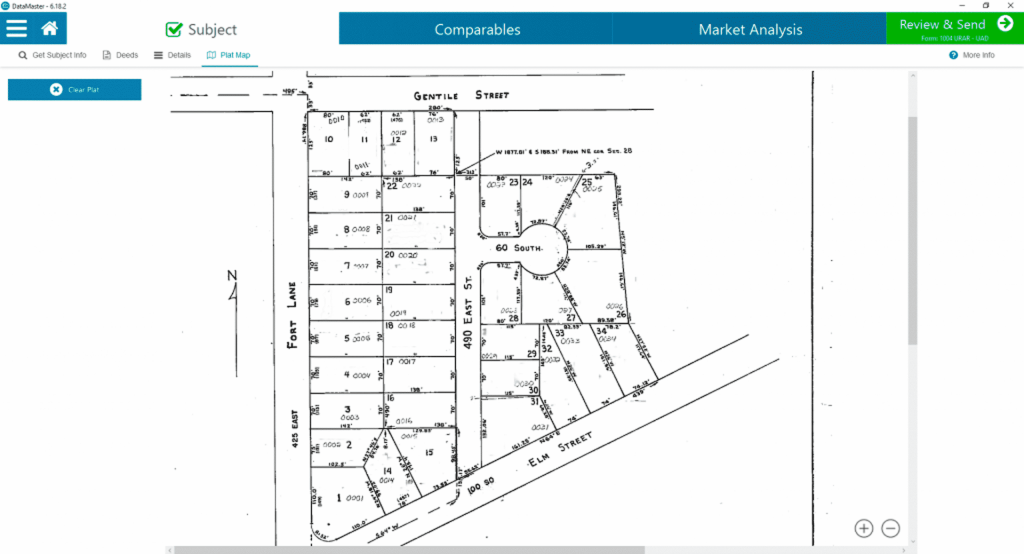5 Ways to Future-Proof Your Appraisal Business

Last week, Jared Preisler, SRA, DataMaster’s Chief Appraiser and I held an hour-long webinar/podcast to address how you can build your appraisal business to withstand changes in the real estate market. We are in the midst of a technological revolution in appraising involving artificial intelligence (AI) and automation. These changes present unique challenges for appraisers. With our 5 Ways to Future-Proof Your Appraisal Business, we came up with a short list of recommendations to help you prepare for the future.
Our list includes getting back to basics, using technology, understanding rules and regulations and how they affect your business, how alternative appraisals present challenges and new opportunities, and the changing market. We will dive deeper into these topics over the next few months, but I’ll give you some tips now that you can use.
As a technology company, we are relatively conservative in our views on how the appraisal industry will change with the advent of new algorithms and tech.
One reason for our conservative nature is a story our founder and president, Rick Lifferth, shares about something that happened to him as a newly-minted employee at an appraisal firm.
In 1973, Rick started working at a firm in Salt Lake City. One day a box came in the mail with a Wang Computer in it. Since he was the youngest professional in the office, Rick’s boss asked him to set it up and get it ready for the office. While he set up the computer, Rick’s boss told Rick that computers would overtake the appraisal business in the next 5 to 10 years.

That was literally 45 years ago, and the appraisal business is still around and employing thousands of people.
This trend of predicting doom for appraisal professionals has continued throughout the years, often when new technology is released, or regulations change. Think of alternative valuation matrixes (matrices?) or AVMs. Around the turn of the century, AVMs were coming for appraisal jobs, and now, alternative appraisals portend the elimination of the appraisal industry.
The point is: there are new technological advances nearly every year, if not more often, and they tend to find use within the appraisal business. Stay calm, and incorporate technology into your appraisal business, and don’t be afraid each time a new company announces a new tool. Above all, make sure you’re comfortable with the tools you use.
1. Back to Basics

If there’s one thing Jared has taught me about the appraisal business, it’s that appraisers must base their appraisals on the basics. If you follow the valuation process, you’ll create a strong foundation that will allow you to include new tools in your business.
The valuation process begins with Defining the Problem. This step gives you the direction you need to complete your assignment. In this step, you should identify your client and intended users. By identifying your client and users, you can map out the problem and come up with a plan of attack. During this stage, you also determine the intended use of your report, the purpose of the assignment, the effective date of the opinion, any relevant characteristics of the property, and assignment conditions (extraordinary assumptions or hypothetical conditions).
The second step is to decide the Scope of Work for the assignment. As an appraiser, this is an essential step because the constraints you put on the job. If your scope of work is too broad, you may do more work than what is needed and come up with a conclusion that doesn’t meet the needs of your audience.
Third, is Data Collection and Analysis, including market analysis and highest and best use analysis. Your analysis leads to the Application of the Approaches to
Value. You must decide which approach fits your assignment. Will you use the Cost Approach, Sales Comparison Approach, or Income Approach? Or will you use more than one method in your report? As a residential appraiser, you’re likely to use the Sales Comparison Approach, although some clients may require additional approaches.
The final two steps include Reconciliation of Value Indications and Final Opinion of Value, then finalizing the report of Defined Value Opinions.
In practice, your appraisal business may use a different flow for your reports, and it may work for you, but this tried and true method is the way Jared runs his appraisal business. Jared’s so focused on getting the process correct he has created a checklist of sorts that he places on each assignment folder in his office, so he has visibility and accountability on each report he signs.
By getting back to basics, Jared has been able to create a successful appraisal business founded on the principles he learned at Continuing Education classes or USPAP training. One of Jared’s favorite quotes is
“Not everything that can be counted counts, and not everything that counts can be counted.”
-Albert Einstein
This quote is indeed accurate in the appraisal business where your knowledge of the local market can often produce different results than an automated shortcut to value.
2. Using Technology
As I mentioned, there’s a constant stream of new technology being introduced. How do you know what tools are useful and which ones aren’t worth your time?
One of the first things you should look at is who developed the tools you’re thinking about using? Is the developer reputable? Does he understand the use of his application to the appraisal business? What is the reputation of the software? Do its reviews describe problems or roadmaps for the application?

You should also ask yourself what the benefit of the application may be. Is it the fabled “easy button” that takes you out of the process? In the appraisal market, no “easy button” can reliably evaluate the factors that lead to a correct valuation of a property. (And an “easy button” violates your role as defined in the USPAP guidelines.)
That said, some products can assist your efforts, and it can be exciting to think of ways you can apply them to your business. For example, Jared found a tool that helps him measure while he inspects a property. However, before Jared put this application to work in his appraisal business, he tested its functionality using other tools, such as a Disto and tape measure.
Another appraiser I talked to told me when he trains new employees; he has them measure properties by hand before moving to other tools to ensure his trainers know how to work without technology in case the technology fails.
To sum up, technology is useful, but you have to understand how it works and its limitations as they relate to your appraisal business.
3. Rules and Regulations
Everyone’s favorite topic 🙂
We recently saw how things change in an instant with a new announcement. I’m talking about Fannie Mae’s announcement about the 1004MC. Suddenly, everyone’s trying to figure out what’s going to change. What does it mean that Fannie Mae no longer requires the 1004MC? Will lenders require it since we have to analyze the local market anyway and since they’re used to seeing it? How will form vendors and software companies support my analysis?
There are always questions at the release of a new regulation. But it usually boils down to how it affects your business.
Take, for example, Advisory Opinion 37 (AO37) – as you know, advisory opinions comment on USPAP but don’t change USPAP. They clarify topics within USPAP to help appraisers with their work.
What was interesting about AO37 was the breadth of the commentary. AO37 clarifies about 15 topics ranging from the USPAP Ethics Rule to Advisory Opinion 18. You can see all of them by clicking here. We put together a simple webpage to show the topics.
Spoiler Alert: AO37 describes how you can work with technology from the standpoint of making your own valuation decisions. At a high level, AO37 instructs appraisers to understand the fundamentals (we’re getting back to basics again) behind the software they use so they can defend their choices. We have a blog post dedicated to AO37, click here to read it.
As you read new publications, try to view them through the lens of your appraisal business and how you can utilize the rules and regulations to your benefit.
4. Alternative Appraisals
Dun dun dun…
 There’s a lot of heartburn about hybrid appraisals and other new valuation initiatives. How do you keep your appraisal business afloat in a changing industry? How do you deal with these changes when you’re being squeezed for every penny?
There’s a lot of heartburn about hybrid appraisals and other new valuation initiatives. How do you keep your appraisal business afloat in a changing industry? How do you deal with these changes when you’re being squeezed for every penny?
There will always be changes in the way business is done. Otherwise, industries grow stagnant. I don’t want to downplay the effect of alternative appraisals. I also don’t want to ignore its impact on the industry. As we’ve seen from property inspection waivers (PIWs), once someone comes out with a new methodology people will adopt it.
Moody’s Investor Service, has even put out statements about the accuracy of hybrid appraisals, and their assessment is not favorable. According to an article published earlier this year in Housing Wire, their analysts show concern for the quality of home valuations, due, in part to the variations in the components of the approaches.
Hybrid appraisals and other alternative appraisals often rely on secondary data collected by an inspector or real estate agent. If you are not aware of the strengths and weaknesses of secondary data, you cannot make informed decisions. The source of data and the methods used to capture data can influence the valuation outcome. To utilize alternative appraisers in your business, you must train your staff to give you the data you need to make a correct valuation.
While I would exercise caution until you understand how alternative appraisals fit into your business model, it’s not the end of the world. Alternative appraisals may help push the industry into viewing appraisers as analysts rather than merely acting as inspectors performing a rote role in the real estate industry.
When I talk about becoming analysts, I think appraisers have the expertise to value a property. Inspectors cannot be relied on to provide the same level of service. Often, there are translation issues between appraisers and inspectors. One thing Jared talks about is the concept of average. To a residential appraiser, average can mean something entirely different than it does to a layperson or even an inspector.
Instead of viewing alternative appraisals as a threat to your business, learn more about the processes. And understand how you can use them in your business. Perhaps, you can build a team that delivers some of this functionality, and you can market it to your clients.
5. Strengthening Your Appraisal Business
This article has dealt with the role of technology and new processes in the appraisal industry. I won’t pretend to know what the future holds for appraisers throughout the country. But there is cause to be optimistic.
In Jared’s business, he often hires staff to perform specific roles that help him turn appraisals around quickly and accurately. For example, he’s employed staff to make his business more efficient and effective. He also examines new technology and uses it to help him make his valuation decisions. With the important caveat that he evaluates and signs off on the tools he uses.
I know that many of you are one-man (or woman) bands in your businesses. This creates special circumstances especially as you try to reduce your turn-time and keep your head above water. There are several strategies you can use to get the help you need. You could hire people on an as-needed basis to perform specific functions. Just make sure you protect your responsibilities as the appraiser. For example, you could hire an IT person to service your computer and keep it up to date. You can use software to move your data into your report, I recommend DataMaster.
Conclusion
What it all boils down to is understanding your role as the appraiser. Are you an analyst with local knowledge and competencies that cannot be replicated by inspectors or computers? Do you have a firm grasp of the foundations of your role? How often are you trying to find out more about upcoming changes?
There are a number of Facebook groups and online forums that can help you stay ahead of changes. Connect with your colleagues and talk through your impressions. Embrace technology with a discerning eye.
Don’t be afraid to try new ideas. You’re uniquely qualified to analyze property and create accurate reports to drive the nation’s economy. You’re an integral part of one of the biggest decisions people make in their lifetimes. If you remember that, you can position yourself to be successful in the future.
If you missed the full webinar on the 5 Ways to Future-Proof Your Appraisal Business, you can watch it here. Jared Preisler and I discussed these five principles and even more.



